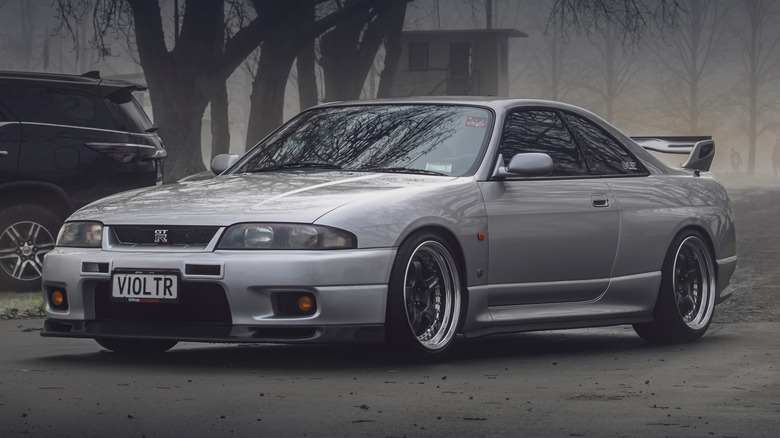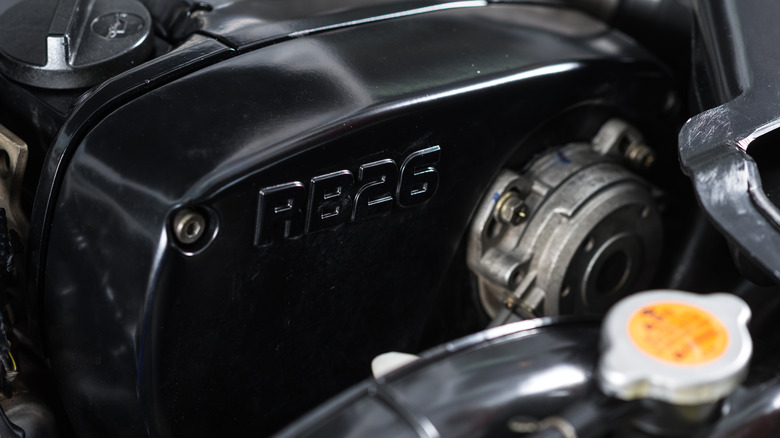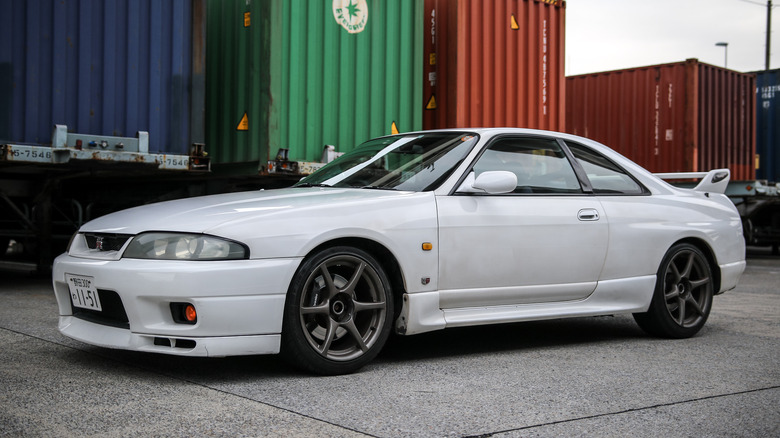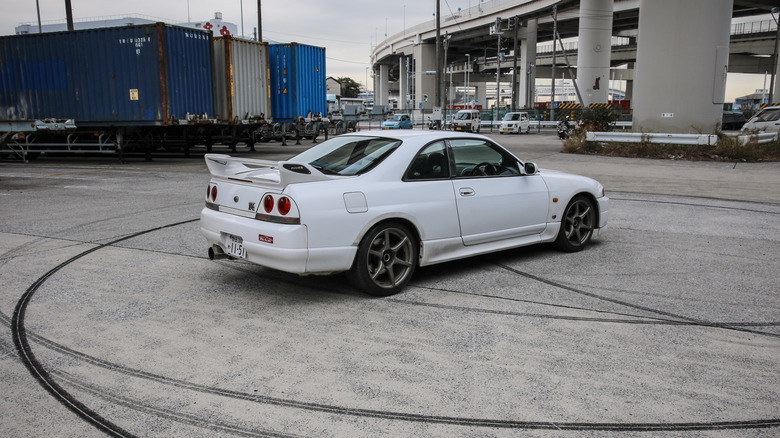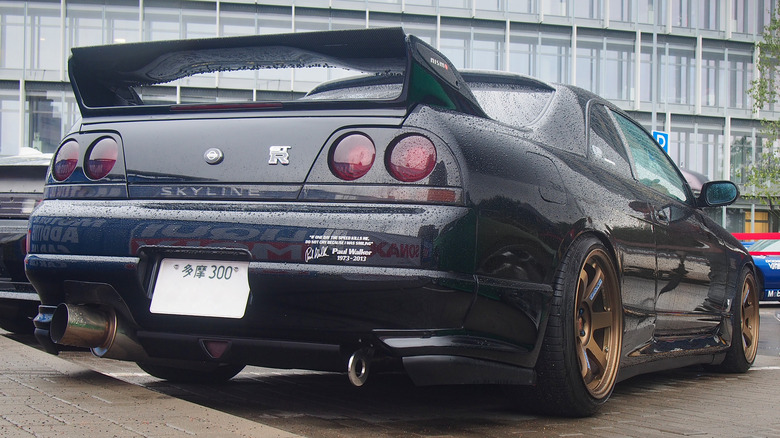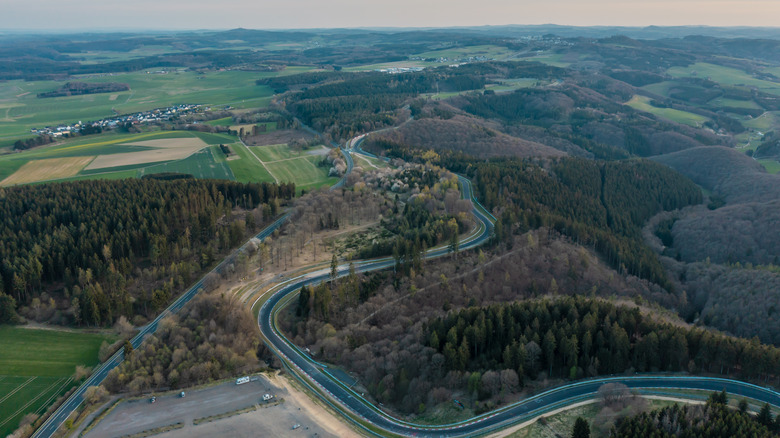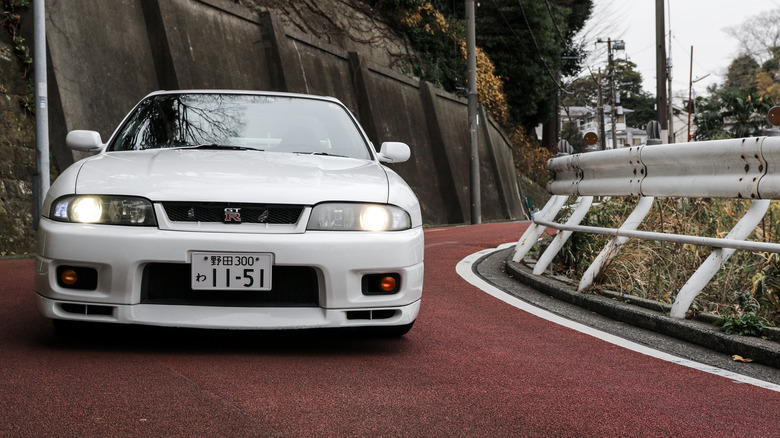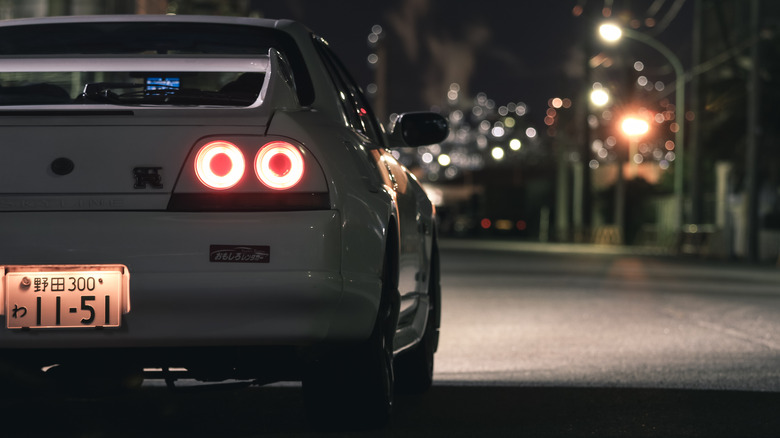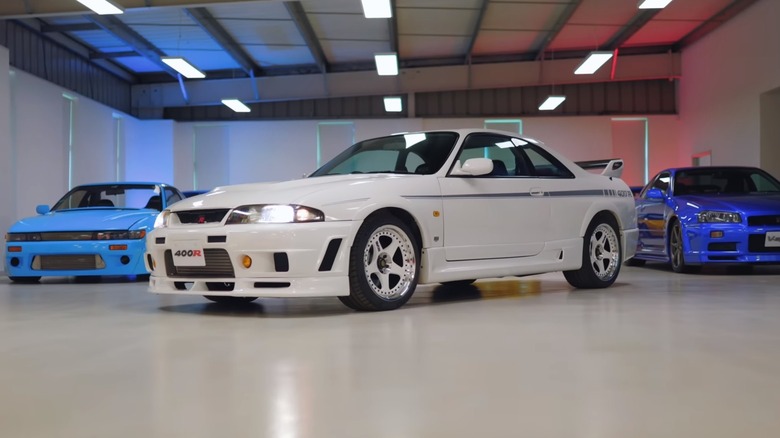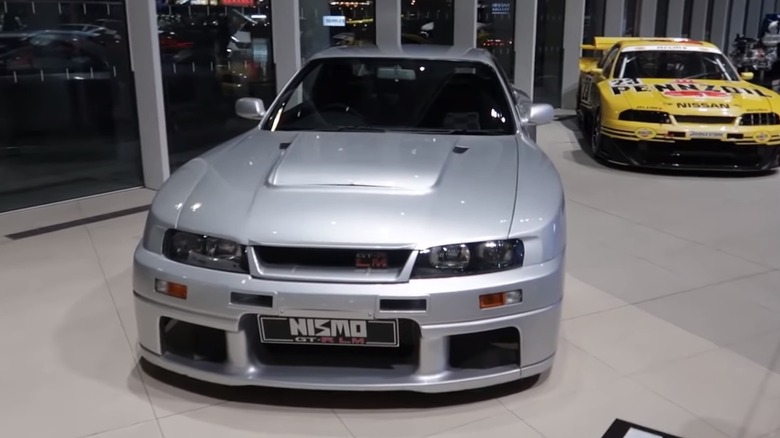The Coolest Features Of The Nissan R33 Skyline
It's always difficult being the middle child. Slotted between the groundbreaking R32 and the segment-defining R34, the R33 Skyline GT-R was always going to have a hard time standing out. Even at its release, its relatively minor improvements over its predecessor limited its appeal, and that mixed reputation has continued to plague it to this day. SlashGear even ranked it the second worst Skyline GT-R generation made, after the C110 Skyline 'Kenmeri' GT-R. Although, even if it wasn't quite as revolutionary as some enthusiasts had hoped, it's worth remembering that the R33 GT-R is still an excellent sports car in its own right, and deserves to be treated as such.
It carried over many of the innovative features that made the R32 such a smash hit with buyers but tweaked as much of the car as possible while still adhering to the restrictions imposed on it by the "gentleman's agreement" that was in place at the time. That agreement prevented Nissan from improving the car's power output, notes Evo, which was the biggest source of frustration for buyers at the time. Even so, take a closer look at the R33 GT-R, and you'll find a car that's faster, sleeker, and more engaging to drive than many would give it credit for.
RB26 engine
One of the main selling points of the R32 Skyline GT-R also became one of the biggest sticking points for the R33, as the newer car didn't bring any significant updates to the engine (via Evo). The car's two turbochargers gained ceramic internals, but apart from that, there were no changes, and the official power output of 276 horsepower stayed the same. Any tuning enthusiast worth their salt will know just how much extra power can be squeezed out of an RB26 with the right modifications, but that doesn't change the fact that, from the factory at least, the R33's engine wasn't officially any better than the R32.
While that sounds like a bad thing, it's worth taking a step back to see the bigger picture here. The RB26 is widely considered to be one of the best JDM engines ever made, and its inclusion in the R32 was one of the key reasons the car was such a game-changer. While, yes, a horsepower boost for the R33 would have been nice, the R33 did gain a small increase in torque, up to 271 lb-ft. That helped make it marginally quicker off the line than its predecessor, running 0-62 mph in 5.4 seconds as opposed to the R32 GT-R's 5.6 seconds. Not to mention, it's an open secret that Nissan didn't completely fulfill its gentleman's agreement anyway, and the true output of the R33 is said to be closer to 330 horsepower than 276 (via Road and Track).
Revised styling
One of the biggest changes between the R32 and R33 came in the form of its styling, which like many other aspects of the car, proved divisive. The aerodynamics were improved through the addition of a new rear wing and revised bodywork, Evo noted, but compared to the theatrical styling of the later R34, the R33 looks a little underwhelming. This simpler design did have the effect of reducing the car's drag coefficient from 0.40 to 0.35, but any improvement in performance this caused was largely offset by the R33's weight gain.
Inside, the car was pretty basic, with cloth sports seats and a dash that focused on function over form. Some would argue that made it more focused than the plusher cabin of the later R34, but again, it simply wasn't as exciting. Even if it wasn't as radical as its predecessor or as theatrical as its successor, the R33's design has arguably aged very well, and looks fairly modern despite being more than a quarter of a century old.
All-wheel drive system
One of the key differences between the Skyline GT-R and other sports cars at the time was its all-wheel drive system, called the Advanced Total Traction Engineering System for All-Terrain, or ATTESA for short. ATTESA was first included on the R32 GT-R and has been on every GT-R model since. The R33 system featured some performance improvements over the original incarnation, the biggest difference being that the R32 could send almost 100% of its torque to its rear wheels in certain situations, whereas the R33 could not. The system in the R32 was great for burnouts, but it was slightly less capable in pure performance terms.
The R33 could only send a minimum of about 90% of its torque to the rear wheels, with the remaining 10% forced to the front. This helped the all-wheel-drive system react quickly to changing conditions, an improvement compounded by an upgraded ECU that could take sensor readings 10 times faster than the previous generation car. All these tweaks made the car more instantly responsive, not only improving acceleration times but ensuring grip remained optimal even when cornering at high speed.
Upgraded V-Spec
In addition to all the tweaks and improvements made to the "standard" R33 GT-R, buyers of the upgraded V-Spec gained access to a few extra new features. The ATTESA system was fitted with a limited-slip differential at the rear to make it even easier to control the car at its limits, with the added effect of increasing braking control. If the V-Spec still wasn't good enough, buyers could opt for the top-tier V-Spec N1 trim, which strengthened engine components, upgraded the oil cooling system, and added a better water pump, notes Road and Track.
The V-Spec N1 came with some restrictions: it was only available in white, and there was no air conditioning system or radio in a bid to shave off every last ounce from its curb weight. Naturally, as the most race-ready version of the R33, it's highly sought after among collectors, so good luck to anyone trying to find a stock example out there for a reasonable price. As with all the other Skyline models, the R33 GT-R has seen a significant price rise in recent years, with V-Spec versions commanding even higher premiums as collectors clamor to get their hands on pristine examples.
Nürburgring record breaker
Some modern car manufacturers seem to have an obsession with Nürburgring times, and it seems like every few months or so, a new model comes along and claims to have broken the all-time record for its segment. Mercedes-Benz is particularly notorious for using the Nordschleife as a marketing tool, with the Mercedes-AMG GT R claiming the all-time record in 2016 and the Mercedes-AMG GT 63 S claiming the title of "fastest four-door coupe" a few years later. Records like this are set by professional test drivers under very strict conditions, and they're not usually replicable by anyone else.
However, when the R33 GT-R set the all-time production car record at the Nürburgring, becoming the first car to record a sub-eight minute time, things were rather different. Road and Track reports that journalists at BestMotoring magazine tried to replicate the record-setting time, and came very close, achieving a best of 8:01.72. These weren't professional race drivers, so the fact they were able to get so close to beating the all-time 'Ring record behind the wheel of an R33 GT-R says all you need to know about its performance potential. This was a serious track weapon, one that was just as potent as the "Godzilla" R32 that came before it, perhaps even more so.
It's now legal to import
Despite the many urban legends surrounding the original import ban on the Skyline GT-R, namely that it was too fast for police to catch or too dangerous, there's a pretty simple reason why the car never officially came to America. The 1988 Motor Vehicle Safety Compliance Act introduced a strict set of restrictions on automakers, making America's crash regulations more stringent than most of the rest of the world. For models where the U.S. was one of the main markets, manufacturers had no choice but to comply, but for smaller-volume, more niche models like the Skyline GT-R, Nissan didn't bother.
However, in 1998 the law was amended to exempt any vehicles that were 25 years of age or older, which means that the R33 is now legal to import and register. Depending on which state you live in, there are still some local emissions and safety regulations that need to be met, with California's being the most notorious. However, if you've got deep enough pockets, there are conversion specialists that can modify the car to meet road-legal requirements in all 50 states. The whole process is still complicated and costly, however, and the wave of added demand since the R33 became legal in the U.S. is one of the biggest factors driving the price of used models on a one-way trend upward.
Rising resale value
With Americans now able to import more classic cars from Japan's golden era and the supply of readily available used examples starting to dry up, the value of the remaining cars has spiked. The R33 has seen its average value increase 9.4% between January 2022 and 2023 according to data from Hagerty, with examples in good condition now fetching $64,200. There are some signs that the resale market might be cooling down a little – in October 2022, values sat even higher at $68,300 on average – but most examples of the R33 are far from what anyone could call "affordable."
Even if there's been a slight value dip in the short term, it's very unlikely that the car will continue to lose value over the long run. During the years where they were relatively affordable in Japan and other export markets, many examples were lost due to reckless driving or poor-quality modifications, and plenty more ended up in junkyards due to rust or mechanical failure. As the Skyline becomes rarer in Japan, some domestic collectors are reportedly turning down huge offers for their cars, so it seems like enthusiasts Stateside might begin finding it more difficult to find examples to import in pristine condition from now on. Anyone with a clean R33 in their garage at the moment, especially a rare one, should see solid returns on their investment in the future.
Ultra-limited Nismo 400R edition
Collectors looking for the ultimate version of the R33 will want a Nismo 400R, the 400 horsepower special edition GT-R which remains one of the most extreme production Nissans ever built. The Nismo 400R was the first car to break the "gentleman's agreement" that had hobbled Nissan's performance cars in the years prior, and it featured a racing engine that had previously appeared in the GT1-class Skylines that raced at Le Mans (via Supercar Nostalgia). This RB-X GT2 engine featured forged pistons, crankshaft, and connecting rods, and racing turbochargers with increased boost were also fitted.
A new engine management system and airflow filter kept the car cool, and the manual transmission was upgraded with a racing-derived clutch and carbon fiber parts. That was in addition to the chassis reinforcements, uprated Brembo brakes, and forged alloy wheels that completed the comprehensive suite of upgrades. A full overhaul from the standard car, then. Despite the 400R's status as an undisputed halo car, it never sold as well as Nissan had hoped. Supercars reported that a total of just 44 examples are believed to have been sold, less than half of the Nismo 400R's original intended run of 100 units. Suffice it to say, examples of the 400R are extremely rare to find for public sale, and when they do change hands, they're quickly snapped up by collectors.
The one-off GT-R LM
Perhaps calling the Nismo 400R the ultimate R33 should come with an asterisk, as there's an even more extreme variant that was never offered for public sale. The R33 GT-R LM was built as a homologation requirement for Nissan to race at the 1995 Le Mans, and since rules dictated that at least one road-legal example needed to be made, a single car was built. It featured the same extreme aero kit as the race GT-R, although its RB26DETT engine was detuned to 300 horsepower, down from the race car's 400 horses.
It's still registered as road-legal in the U.K., although it never leaves Nissan's storage facility in Japan. Almost no one is allowed behind the wheel of the car, with Top Gear reporting that even Nissan's chief executive at the time wasn't allowed to drive it. It's a true unicorn, the forbidden fruit of the R33 range, and one of the Skyline lineage's coolest hidden gems.
